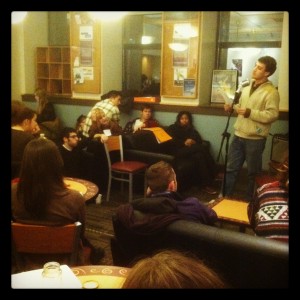Creative Campus Intern Sewon Kang ’14 reflects on the Creative Campus course “Blood, Muscle, Bone: The Anatomy of Wealth and Poverty,” and the “Blood, Muscle, Bone” Performative Teach-In.

I’ve been thinking back on the course “Blood, Muscle, Bone: The Anatomy of Wealth and Poverty” and I must say that it was a total interruption in my squarely traditional education. Throughout the intensives, my fellow students and I explored difficult problems related to wealth distribution in the U.S. with our instructors, Liz Lerman and Jawole Zollar. In my prior post, I discussed my enthusiasm for the interdisciplinary nature of this course and the deep processing made possible through artistic exploration. Now that the class has ended, I want to share how it continues to impact my life.
Even though it was primarily a dance course, we explored the realities of disparity in a traditional, academic way—we learned facts and figures, read literature, and applied the knowledge by considering how it affects the Wesleyan community. What was unique was that once we had all of this information, we were given the freedom to respond to aspects that resonated with us. Our expressions then gave shape to the structure of the performative teach-in, the culminating event for the course. It was a truly collaborative outpouring and was the perfect way to end a process that is in reality constant and continuous. The teach-in allowed us to take some of what we learned and put it in a format that we could share with our fellow students and community—something that doesn’t happen in a typical classroom.
The night began with a talk by Anne Farrow, a journalist and author who studies enslavement in New England. She shared passages from her new book about the life of a slave trader who lived in Middletown. As performers, we listened to the lecture and responded with our bodies in ways that disrupted the usual speaker-listener dynamic. These interruptions continued during Professor William Arsenio’s lecture on economic disparity and recent psychological studies that examine how people understand wealth distribution in this country. We analyzed the facts and statistics he presented, reflected on our past experiences, and translated information visually. For the rest of the teach-in, we took numbers and words and made them tangible by sharing personal stories through song, spoken word, and movement.
This exploration was incredibly intense and was only made possible by an extraordinary willingness to participate in experimental learning—a leap that I’m grateful to my classmates for taking with me. Everyone was fully committed to the class, showing strong enthusiasm for the topic at hand and complete dedication to the process, even during times when everything was uncomfortably new. The class was a learning community so unlike any I have ever experienced.
One of the most challenging and exciting aspects for me was the act of performing. Throughout the course, Liz and Jawole expertly drew out flickers of performance from each of us and helped us develop strong structures that we could be proud of. Such in-class dynamics translated into powerfully moving moments of the teach-in, revealing how wealth and poverty touch everyone’s lives. During a discussion about white privilege, I was able to share my frustrations with other students of color in the class. Jawole and Keith Thompson, who assisted Liz and Jawole in the course, helped me eventually become comfortable with sharing my struggles with the audience at the teach-in. They taught me that vulnerability can be useful, and because I believed so strongly in the work that we were doing, I knew that my story needed to be shared.
This opened doors for me as a student who is used to articulating ideas through very specific structures, such as the five-paragraph analytic paper. What I learned is that like the academic paper, performing is a method of processing, albeit one that is less frequently encountered outside of certain circles. During “Blood, Muscle, Bone,” I was asked to perform my thoughts and became a student of a different kind of processing. For some of my classmates, it was liberating to engage in this alternative way of knowing because they had been searching for this kind of creative outlet. Personally, I learned that this kind of communicating works for me because it’s an effective way for me to address problems in a constructive manner. Once I leaned into the discomfort of vulnerability, I could let the process of performing take over.
As I walk away from this course, I do so with more awareness of my position in the world. I understand better how I operate within the global structures of wealth and poverty. I know how profoundly unequal things are; it runs hot through my blood and weighs heavy on my muscles and bones. Whether I’m complicit or not, whether I’m an agent or a casualty, wherever I situate myself, what am I going to do about it? How am I going to use my voice? We, the participants of “Blood Muscle Bone,” move to declare ourselves as a group of people who will no longer abide by inequality. We establish ourselves as a group of people who are dedicated to bringing about change and invite others to join us in this stance.










